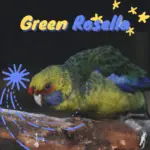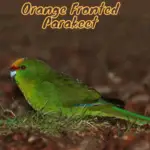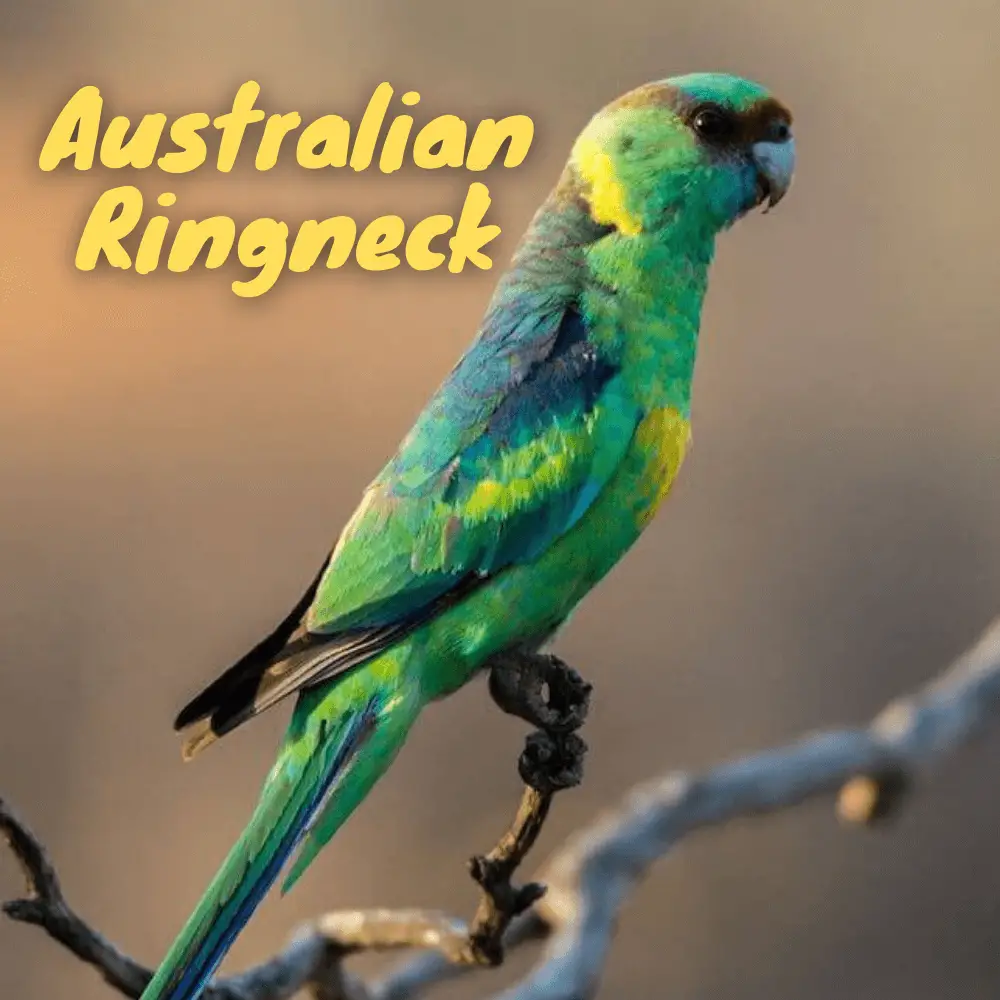
Australian Ringneck 32–44 cm; 121–200 g (nominate group), 105–143 g (Bernardi group). Head dull blue-black sometimes with a red frontal band;
yellow collar broke at throat; breast, mantle, back and wings green hazed pale blue, with fuller pale blue edging on median and outer secondary-coverts, primaries blackish;
belly yellow shading to yellowish-green on vent and under tail-coverts; rump and tail blue-green, latter darker distally and with outer feathers pale blue shading to white at tips.
Australian Ringneck Female similar but generally greener with head browner, with slightly smaller bill and head, and may show underwing bar. Immature duller; adult plumage achieved in 12–15 months.
Race semitorquatus larger, with the strong red frontal band (can be absent in female), green belly and most birds (both sexes) show wingbars; accidental smaller, lacks red frontal band, with pale blue lower ear-coverts, yellow of belly paler, and extending to under tail-coverts.
Race Bernardi has head and undersides mainly green, also with the red frontal band, dark green hind crown joining postocular stripe, with pale blue tinge at the base of the bill, yellow half-collar across nape; mantle and back blackish blue, scapulars and secondaries dark green;
lesser wing-coverts dark blue, primary and outermost secondary-coverts pale blue, median and other secondary-coverts green, primaries blackish, rump mid-green, and tail dark green with blue outer feathers that shade to white at tips;
Australian Ringneck female duller, with paler mantle and evidence of wing stripe, and immature like a female with brownish-green head.
Race white has a dark grey-green mantle, and a brownish crown; race MacGillivray lacks a red forehead and replaces dark green of crown, mantle, and tail with paler green, as well as having more blue on the face, and belly yellow.
SOURCE: polytelismedia
Systematics History
Editor’s Note: This article requires further editing work to merge existing content into the appropriate Subspecies sections. Please bear with us while this update takes place.
Molecular and morphological analysis has shown that the characters defining the forms semitorquatus, MacGillivray, and Bernardi are unstable and inconstant and that genetically there is poor evidence for recognizing more than one species (B. zonarius), with just two subspecies (zonarius and Bernardi).
While a single species of Barnardius is accepted here, with synonymization of races occidentalis and white (recognized in HBW), four populations are judged to be sufficiently distinct, despite the remarkable degree of variation within each one, to warrant subspecific recognition (following main published authority ).
Forms myrtle and Dundas are, like accidental, included within nominate zonarius; form white is judged to be an intergrade between nominating and Barnard. Four subspecies were recognized.
Subspecies
Feral population (presumably nominate race) around Melbourne, Victoria.
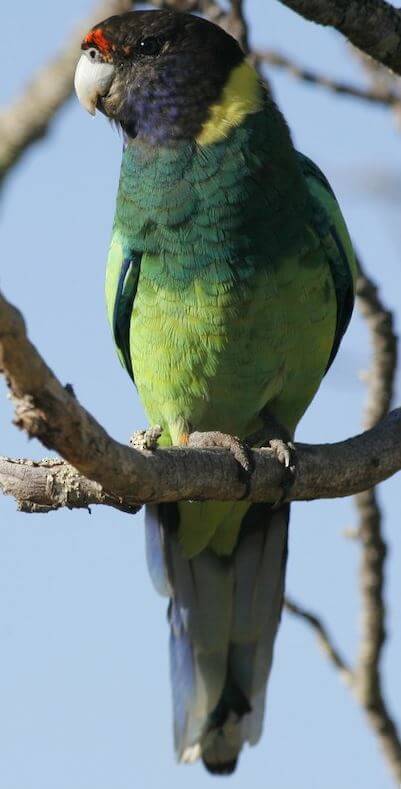
Distribution
Editor’s Note: Additional distribution information for this taxon can be found in the ‘Subspecies’ article above. In the future, we will develop a range-wide distribution article.
Habitat
The wide variety used, including dense coastal forests, Wheatbelt farmlands, mallee and semi-arid Eucalyptus woodlands, arid Acacia or Casuarina interior scrublands, and even sparsely vegetated country as long as tree-lined watercourses penetrate them to provide nest-sites.
Race Bernardi inhabits mallee (low Eucalyptus scrubland), open woodland and trees along watercourses, Callitris woodland, and Acacia scrub; race MacGillivray prefers woodland savanna and riverside forest, especially in hilly country.
Movement
Normally sedentary in more wooded parts of the range, but in arid country nomadic movements recorded, e.g. many thousands appeared on NW edge of Nullarbor Plain, Jan 1975, and are probably common in response to water availability.
Diet and Foraging
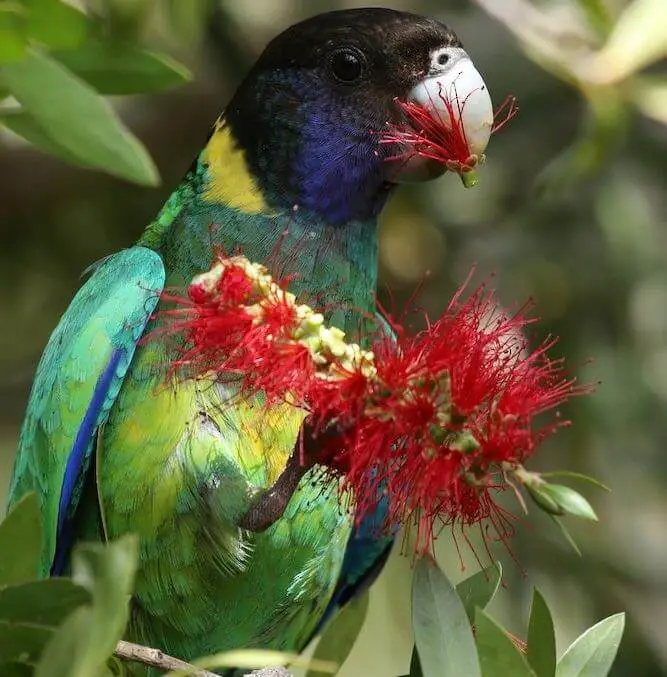
In forest areas, fruits and sometimes nectar of Eucalyptus, especially marri (E. calophylla), and other species, including exotic ornamentals such as Melia azedarach;
in more arid country, seeds of grasses and herbaceous plants, with birds seen digging up corms of onion grass (Romulea longifolia), eating small leaves of capeweed (Cryptostemma calendula) and taking grain spilled by lorries along roads.
Stomachs held seeds of Lysiana exocarp, Solanum and mistletoe, Eremophila buds, and wood-boring larvae. Birds pull back eucalypt bark to obtain lerps, and eat sawfly Perga larvae from eucalypt seedlings and Macrobathra moth larvae from galls on Cassia; and can damage cereal crops and cultivated fruit.
Australian Ringneck Diet of race Barnard includes seeds of paddymelons (Cucumis myriocarpus), bitter melons (Citrullus lanatus), fruits of introduced tobacco tree (Nicotiana glauca), and blossoms and seeds of various Eucalyptus species, including E. camaldulensis, E. gracilis and E. cladocalyx, are known to be favored.
One study recorded the following items in stomach contents of race Bernardi: Pinus pinaster (seeds), Watsonia bulbillifera (aerial bulbils), Avena barbata (seeds), Lagurus ovatus (seeds), Schinus terebinthifolia (fruit), Foeniculum vulgare (seeds),
Arctotheca calendula (flowers), Conyza albida (flowers, seeds), Olearia Mueller (seeds), Diospyros virginiana (fruit), Salvia verbenaca (seeds), Chamelaucium uncinatum (flowers), Eucalyptus camaldulensis (buds, seeds), E. maculata (flowers), E. rudis (seeds), Leptospermum laevigatum (seeds),
L. nitens (seeds), Pericalymma ellipticum (seeds), Olea europaea (fruit), Persoonia saccata (fruit) and Lycium ferocissimum (fruit).
Commonly feeds on the ground, and grass seeds, plus those of Portulacaceae and Solanum, have been found in stomachs.
Australian Ringneck Call
Variety of calls including a disyllabic “whee-eck”, a short alarm “vatch”, a strident “put-kleepit-kleepit” or “king-king-king-king” and various chattering notes; race semitorquatus gives distinctive “twenty-eight” or “tweet-tweet” call, while immature utters bisyllabic “ter-lp”.
The Barnard group is generally less vocal or noisy, including a harsh metallic alarm, a ringing, high-pitched “Kling-Kling-Kling” or “put-keep put-keep”, which is less strident than analogous vocalization of race zonarius,
also a “kwink-kwink” or “Chuk-chuk-chuk” and chattering notes while feeding in trees (usually silent when foraging on the ground).
SOURCE: Tim Siggs
Breeding
Nominate group breeds Aug–Feb in C & S of range, sometimes with two broods, and Jun–Sept in N of range; Bernardi group Aug–Jan, if not delayed or even prevented by drought.
Nest in hole in a tree, commonly in salmon gum (Eucalyptus salmonophloia) and wandoo (E. wandoo), with the lining of wood chips; MacGillivray selects Eucalyptus camaldulensis.
Australian Ringneck Eggs 4–7, usually five; incubation lasts 19–20 days, by female alone; young initially fed solely by the female for the first week, then by both adults;
Australian Ringneck nestling period c. 5 weeks and young may remain with adults for a short period of time thereafter. Possible hybrid with Platycercus adscitus observed in SW Queensland.
Conservation Status
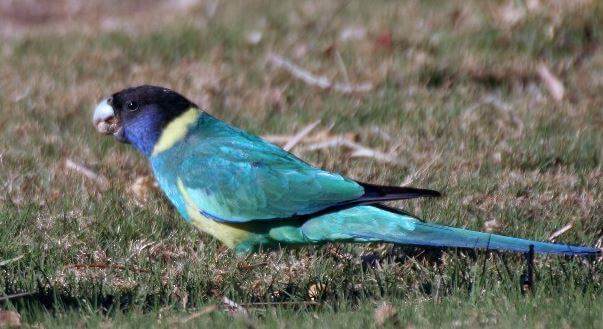
Not globally threatened. CITES II. A fairly common species throughout one-third of the Australian continent, and abundant in Western Australian Wheatbelt (considered perhaps the commonest bird species,
with a population well above 100,000 parakeets) wherein two shires an open season has existed to control crop depredations; the creation of reservoirs for livestock has benefited populations in pasturelands.
However, poor regeneration of nest trees, which are many hundreds of years old, is a long-term cause for concern. Race Bernardi is apparently intolerant of human settlement of range, declining in face of mallee and woodland clearance for grazing and cultivation.
Race MacGillivray, often judged uncommonly, is fairly plentiful and widespread. The total population of the Bernardi group is at least 500,000 birds. Moderate numbers of species are held in captivity, especially in Australia.

